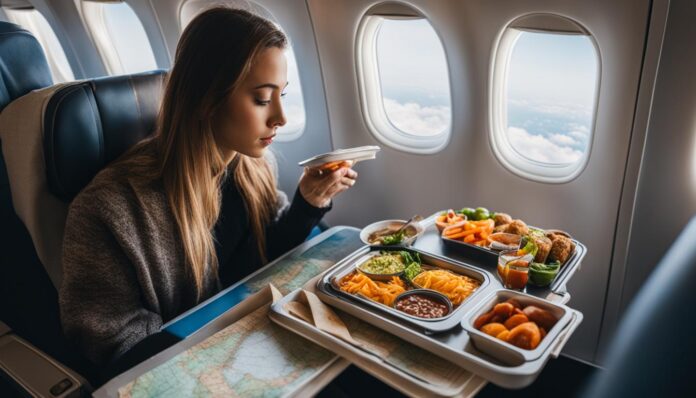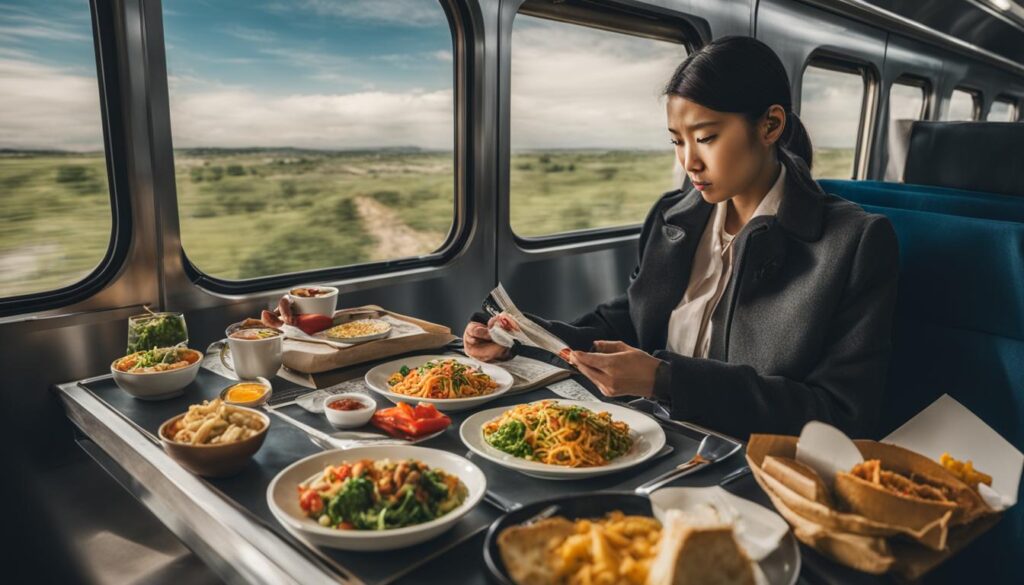Traveling is an exciting adventure, but if you have dietary restrictions, it can also be a challenge. Whether you have food allergies, follow a vegan or vegetarian diet, or require gluten-free options, managing your dietary needs on the road is crucial for a safe and stress-free trip. In this section, we will provide expert tips and solutions to help you enjoy your travels while adhering to your dietary restrictions. From food allergy management to finding vegetarian options and travel diet restrictions, we have you covered.
Understanding Dietary Restrictions and Travel
Before embarking on your journey, it’s crucial to comprehend your dietary restrictions and the impact they may have on your trip. Traveling with dietary restrictions can be challenging, but proper preparation can make it stress-free.
Common Dietary Restrictions
There are several dietary restrictions that one may follow, including food allergies, vegan or vegetarian diets, and gluten-free requirements.
Food allergies can cause severe reactions and can be a major concern while traveling. Common allergens include peanuts, tree nuts, shellfish, fish, dairy, eggs, wheat, and soy. It is essential to carry the necessary medication and inform your travel companions about your allergy.
A vegan diet excludes all animal products, including meat, fish, eggs, and dairy. It can be difficult to find suitable vegan options, especially in countries where veganism is not as prevalent.
A vegetarian diet eliminates meat but may include dairy, eggs, and other animal products depending on the individual’s preference. It may be easier to find vegetarian options, but it’s still essential to check for hidden ingredients.
A gluten-free diet excludes wheat and other gluten-containing grains and may be necessary for individuals with celiac disease or gluten intolerance. It’s important to research gluten-free options and inform restaurant staff about your dietary needs.
Implications for Travelers
Not adhering to your dietary restrictions while traveling can lead to discomfort, illness, or even a medical emergency.
Suppose you have a food allergy and accidentally consume the allergen, especially when traveling alone. In that case, it can result in a severe reaction and no immediate assistance.
Additionally, finding suitable food options can be challenging, and unfamiliar cuisines may contain hidden ingredients that do not align with your restrictions.
It’s crucial to research your destination and communicate your dietary needs to ensure a safe and enjoyable travel experience.
A comprehensive understanding of your dietary restrictions is vital to navigate them while traveling. The next section will provide tips for researching your destination and finding suitable food options while adhering to your dietary requirements.
Researching Your Destination
When managing dietary needs on the road, your research will be your best friend to ensure every meal is a success. Here are some ways to find information about local cuisine and resources that cater to specific dietary needs:
- Check travel guides and websites for information about restaurants that cater to specific dietary needs.
- Search for blogs or forums that discuss dietary restrictions in your destination.
- Use apps, such as Happy Cow, to discover vegetarian and vegan-friendly restaurants in your area.
- Ask for recommendations from locals or your hotel staff.
It’s also essential to research local supermarkets and grocery stores to ensure you can easily find the necessary ingredients for your dietary needs.
Below is a table of popular dietary restrictions and the types of local food options that are typically safe for each type of diet:
| Dietary Restriction | Safe Local Food Options |
|---|---|
| Gluten-free | Fresh fruit, vegetables, rice, potatoes, grilled meat and fish |
| Vegan | Legumes, tofu, grains, fruits, vegetables, nuts, seeds |
| Vegetarian | Dishes with cheese, eggs, beans, peas, lentils, nuts, and seeds |
| Pescatarian | Fish, seafood |
| Halal/Kosher | Specific food items that follow these guidelines |
Packing Travel-Friendly Snacks
When having to manage dietary restrictions during travel, it is important to pack travel-friendly snacks that align with your dietary needs. It can be challenging to find food options that comply with your dietary restrictions, especially when traveling to unfamiliar places where healthy food options may be limited.
Having healthy snacks readily available can sustain you during your journey and help you avoid hunger cravings. Moreover, it can save the day if you get delayed in a location that doesn’t have any convenient places to eat or that doesn’t accommodate your dietary needs.
Here are some suggestions for nutritious and convenient snacks that you can pack for your travels:
| Snacks | Description |
|---|---|
| Dried Fruits and Nuts | Packed with vitamins and minerals, these snacks are ideal for travelers and can satisfy your sweet or crunchy cravings. Go for unsalted or low-sugar options. |
| Seed Crackers | Packed with fiber and protein, seed crackers are a healthy and satisfying snack that can spruce up your sandwich or work as a standalone snack. Choose gluten-free or vegan options if needed. |
| Roasted Chickpeas | Roasted chickpeas are a great source of protein and come in many delicious flavors. They are a perfect travel snack choice that can help you avoid unhealthy alternatives on the road. |
Don’t forget to pack a refillable water bottle to keep yourself hydrated and avoid buying sugary drinks on the go. You can also bring some tea bags if you want to enjoy a hot beverage, or a protein bar if you need something to tie you over until your next meal.
Packing travel-friendly snacks that align with your dietary restrictions is an essential part of managing your dietary needs on the road. With these snack suggestions, you can ensure that you have nutritious and tasty options to sustain you during your journey.
Communicating Your Dietary Needs
When dining out or seeking food options during your travels, it is crucial to effectively communicate your dietary restrictions to avoid any health risks. To make sure your needs are understood, try the following:
- Learn some key phrases in the local language: Study some common food-related words and phrases, or download a language app to help you communicate your dietary requirements in the local language.
- Use dietary restriction cards: Carry cards with your dietary restrictions written on them in the local language. Show them to servers or restaurant staff to ensure they understand what you cannot consume. You can make your cards at home or purchase them from online retailers.
- Use apps: There are several apps available that allow you to specify your dietary restrictions and receive food recommendations and reviews from other travelers.
Properly communicating your dietary needs is an important step towards managing your dietary restrictions on the road. By following these tips, you can ensure that your needs are met while enjoying the local cuisine.
Navigating Restaurant Menus
Dining out is an enjoyable part of travel, but it can be challenging when you have dietary restrictions. Fortunately, there are strategies to help you navigate restaurant menus, find vegetarian or vegan options, and communicate with restaurant staff to ensure that your dietary needs are met.
Here are some tips to help you enjoy dining out while managing your dietary restrictions on the road:
- Research restaurants ahead of time: Look for restaurants that offer vegetarian or vegan options, or that cater to specific dietary needs. Check their menus online to determine if they have suitable options.
- Communicate your dietary restrictions: When making a reservation or arriving at the restaurant, inform the staff of your dietary needs. Explain your restrictions clearly so that they can better assist you.
- Ask about ingredient substitutions: If a dish includes an ingredient that you cannot eat, ask if it can be substituted with a suitable alternative.
- Customize your order: Many restaurants are willing to customize dishes to accommodate dietary restrictions. Don’t be afraid to ask for modifications that fit your dietary needs.
Finding Vegetarian and Vegan Options
Even if a restaurant does not have specific vegetarian or vegan dishes on its menu, there are often ways to modify existing dishes to meet your dietary needs. Here are some ideas for finding vegetarian and vegan options:
- Look for vegetable-based dishes: Salads, soups, and stir-frys can often be made vegetarian or vegan with slight modifications.
- Ask for dairy or meat substitutions: Dishes that include cheese or meat can often be modified with tofu or plant-based cheese substitutes.
- Order sides as a meal: Many restaurants offer delicious vegetarian or vegan side dishes that can be combined to create a satisfying meal.
- Try ethnic cuisine: Indian, Thai, and Middle Eastern restaurants often have vegetarian or vegan options, and are great places to explore new flavors.
“By researching restaurants ahead of time, communicating with staff, and customizing your order, dining out can be a stress-free and enjoyable part of your trip, no matter your dietary restrictions.”
Exploring Local Specialties and Ingredients
Traveling to new destinations gives you the unique opportunity to experience the local cuisine and flavors. However, managing dietary restrictions during travel can make it challenging to fully immerse yourself in the local food culture. Fortunately, there are ways to explore local specialties and ingredients while still adhering to your dietary needs.
One way to do this is by researching local ingredients before your trip. This can help you identify dishes that are safe for you to eat and give you a better understanding of what to look for on menus. You can also reach out to local food bloggers or social media groups to learn more about the best places to find food that meets your dietary restrictions.
Another option is to seek out specialty food stores or markets that cater to specific dietary needs. These stores often have a wide selection of local and international specialty products, including gluten-free, vegan, and organic options. You may even discover new ingredients and products that you can incorporate into your own cooking back home.
Don’t be afraid to ask locals for recommendations, too. They may be able to suggest hidden gem restaurants or street food vendors that offer delicious dishes that align with your dietary restrictions.
Exploring local specialties and ingredients can be a rewarding and exciting part of your travel experience. By doing your research, seeking out specialty stores and markets, and asking locals for recommendations, you can explore the local food culture while staying true to your dietary needs.
Dealing with Unexpected Situations
Even with thorough planning, unexpected situations can occur when traveling with dietary restrictions. It’s essential to know how to handle emergencies and find alternatives in unfamiliar environments. Here are some tips to help you manage unexpected situations during your travels.
Always Have Emergency Snacks
When you’re traveling, it’s always a good idea to have emergency snacks on hand. These can include dried fruit, protein bars, or nut butter packets. You never know when you might be stuck in a situation where food options are limited, and having a backup plan can save you from going hungry.
Bring a Translation Card
If you’re traveling to a country where you don’t speak the local language, it’s essential to have a translation card that communicates your dietary restrictions. These cards are available to purchase online or at travel stores and can help you communicate your needs to restaurant staff or other locals. Some translation apps can also help you communicate your dietary restrictions in foreign languages.
| Dietary Restriction | Translation Card/App |
|---|---|
| Vegetarian | “I don’t eat meat or fish. Do you have any vegetarian options?” |
| Gluten-Free | “I can’t eat anything that contains wheat, barley, or rye. Do you have any gluten-free options?” |
| Vegan | “I don’t eat any animal products, including meat, fish, dairy, or eggs. Do you have any vegan options?” |
| Food Allergy | “I’m allergic to [insert allergen]. Can you recommend any dishes that don’t contain [allergen]?” |
Research Nearby Grocery Stores
If you’re staying in a location for an extended period, it’s worth researching nearby grocery stores that carry foods that align with your dietary restrictions. This can sometimes be a more convenient and affordable option than relying solely on restaurants.
Stay Calm and Flexible
Despite your best efforts, there may be situations where you’re unable to find suitable food options that meet your dietary restrictions. It’s important to stay calm and remain flexible, as stress and anxiety can exacerbate existing health conditions. Be prepared to improvise and try new foods that may not be typical to your regular diet.
Unexpected situations can be challenging, but by following these tips, you can remain prepared and manage your dietary restrictions while enjoying your travels to the fullest.
Conclusion
Traveling with dietary restrictions can be challenging, but it doesn’t have to be overwhelming. By researching your destination, packing travel-friendly snacks, communicating your needs, and navigating restaurant menus, you can enjoy your trip safely and stress-free.
Remember to always be prepared for unexpected situations and have a plan in place for emergencies. With proper planning and communication, you can indulge in local specialties and fully immerse yourself in the local food culture without compromising your dietary restrictions.
We hope our expert tips and strategies have provided valuable insights and guidance for managing your dietary restrictions during travel. Bon voyage!
Keywords: dietary restrictions during travel

















































